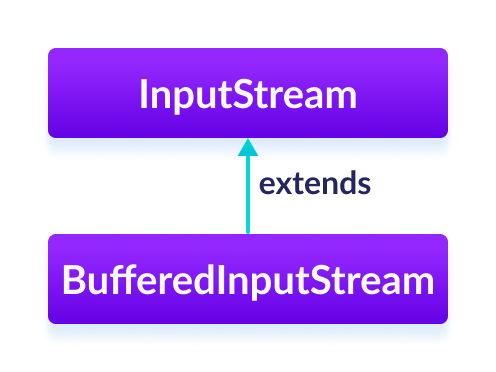The BufferedInputStream class of the java.io package is used with other input streams to read the data (in bytes) more efficiently.
It extends the InputStream abstract class.

Working of BufferedInputStream
The BufferedInputStream maintains an internal buffer of 8192 bytes.
During the read operation in BufferedInputStream, a chunk of bytes is read from the disk and stored in the internal buffer. And from the internal buffer bytes are read individually.
Hence, the number of communication to the disk is reduced. This is why reading bytes is faster using the BufferedInputStream.
Create a BufferedInputStream
In order to create a BufferedInputStream, we must import the java.io.BufferedInputStream package first. Once we import the package here is how we can create the input stream.
// Creates a FileInputStream
FileInputStream file = new FileInputStream(String path);
// Creates a BufferedInputStream
BufferedInputStream buffer = new BufferInputStream(file);
In the above example, we have created a BufferdInputStream named buffer with the FileInputStream named file.
Here, the internal buffer has the default size of 8192 bytes. However, we can specify the size of the internal buffer as well.
// Creates a BufferedInputStream with specified size internal buffer
BufferedInputStream buffer = new BufferInputStream(file, int size);
The buffer will help to read bytes from the files more quickly.
Methods of BufferedInputStream
The BufferedInputStream class provides implementations for different methods present in the InputStream class.
read() Method
read()- reads a single byte from the input streamread(byte[] arr)- reads bytes from the stream and stores in the specified arrayread(byte[] arr, int start, int length)- reads the number of bytes equal to the length from the stream and stores in the specified array starting from the position start
Suppose we have a file named input.txt with the following content.
This is a line of text inside the file.
Let's try to read the file using BufferedInputStream.
import java.io.BufferedInputStream;
import java.io.FileInputStream;
class Main {
public static void main(String[] args) {
try {
// Creates a FileInputStream
FileInputStream file = new FileInputStream("input.txt");
// Creates a BufferedInputStream
BufferedInputStream input = new BufferedInputStream(file);
// Reads first byte from file
int i = input .read();
while (i != -1) {
System.out.print((char) i);
// Reads next byte from the file
i = input.read();
}
input.close();
}
catch (Exception e) {
e.getStackTrace();
}
}
}
Output
This is a line of text inside the file.
In the above example, we have created a buffered input stream named buffer along with FileInputStream. The input stream is linked with the file input.txt.
FileInputStream file = new FileInputStream("input.txt");
BufferedInputStream buffer = new BufferedInputStream(file);
Here, we have used the read() method to read an array of bytes from the internal buffer of the buffered reader.
available() Method
To get the number of available bytes in the input stream, we can use the available() method. For example,
import java.io.FileInputStream;
import java.io.BufferedInputStream;
public class Main {
public static void main(String args[]) {
try {
// Suppose, the input.txt file contains the following text
// This is a line of text inside the file.
FileInputStream file = new FileInputStream("input.txt");
// Creates a BufferedInputStream
BufferedInputStream buffer = new BufferedInputStream(file);
// Returns the available number of bytes
System.out.println("Available bytes at the beginning: " + buffer.available());
// Reads bytes from the file
buffer.read();
buffer.read();
buffer.read();
// Returns the available number of bytes
System.out.println("Available bytes at the end: " + buffer.available());
buffer.close();
}
catch (Exception e) {
e.getStackTrace();
}
}
}
Output
Available bytes at the beginning: 39 Available bytes at the end: 36
In the above example,
- We first use the
available()method to check the number of available bytes in the input stream. - Then, we have used the
read()method 3 times to read 3 bytes from the input stream. - Now, after reading the bytes we again have checked the available bytes. This time the available bytes decreased by 3.
skip() Method
To discard and skip the specified number of bytes, we can use the skip() method. For example,
import java.io.FileInputStream;
import java.io.BufferedInputStream;
public class Main {
public static void main(String args[]) {
try {
// Suppose, the input.txt file contains the following text
// This is a line of text inside the file.
FileInputStream file = new FileInputStream("input.txt");
// Creates a BufferedInputStream
BufferedInputStream buffer = new BufferedInputStream(file);
// Skips the 5 bytes
buffer.skip(5);
System.out.println("Input stream after skipping 5 bytes:");
// Reads the first byte from input stream
int i = buffer.read();
while (i != -1) {
System.out.print((char) i);
// Reads next byte from the input stream
i = buffer.read();
}
// Closes the input stream
buffer.close();
}
catch (Exception e) {
e.getStackTrace();
}
}
}
Output
Input stream after skipping 5 bytes: is a line of text inside the file.
In the above example, we have used the skip() method to skip 5 bytes from the file input stream. Hence, the bytes 'T', 'h', 'i', 's' and ' ' are skipped from the input stream.
close() Method
To close the buffered input stream, we can use the close() method. Once the close() method is called, we cannot use the input stream to read the data.
Other Methods Of BufferedInputStream
| Methods | Descriptions |
|---|---|
mark() |
mark the position in input stream up to which data has been read |
reset() |
returns the control to the point in the input stream where the mark was set |
To learn more, visit Java BufferdInputStream (official Java documentation).